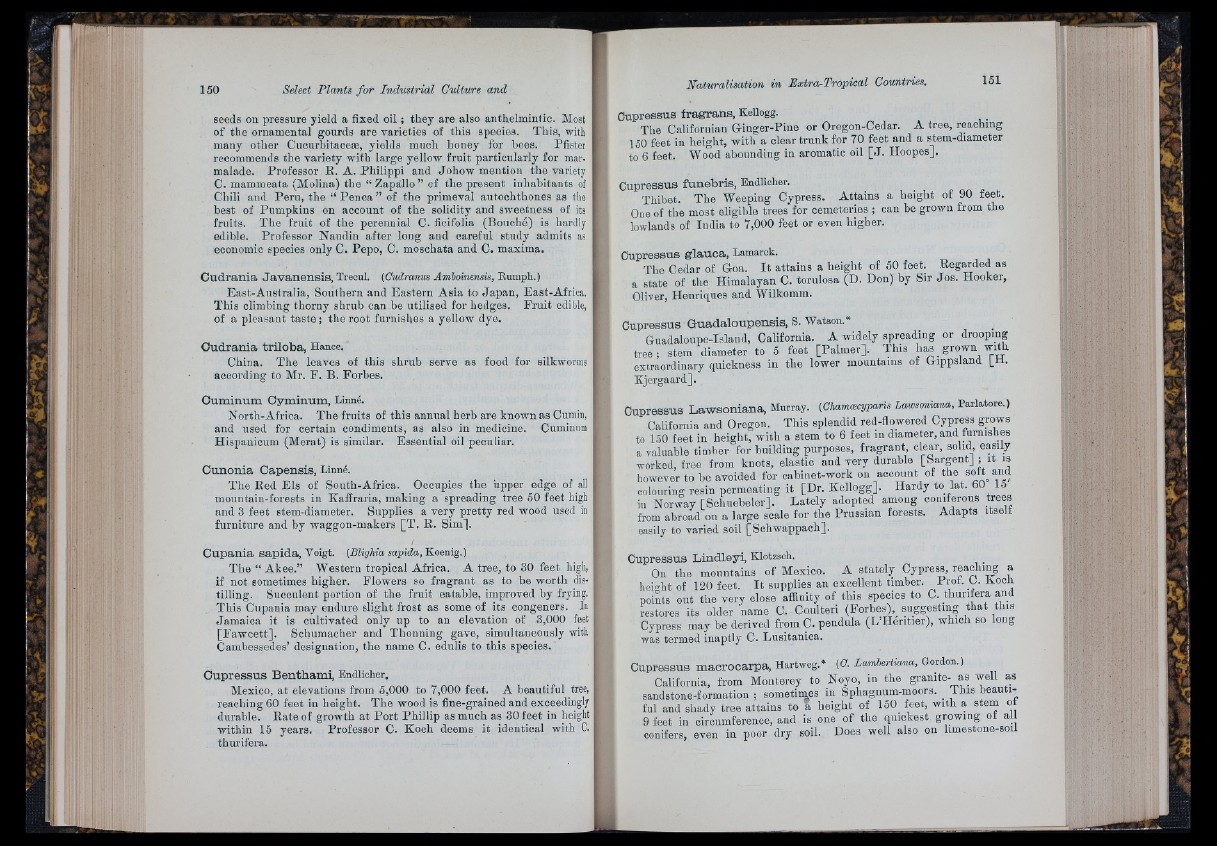
seeds on pressure yield a fixed oil ; they are also anthelmintic. Most
of the ornamental gourds are varieties of this species. This, with
many other Cucurbitaceæ, yields much honey for bees. Pfister
recommends the variety with large yellow fruit particularly for mar.
malade. Professor R. A. Philippi and Johow mention the variety
C. mammeata (Molina) the “ Zapallo ” of the present inhabitants of
Chili and Peru, the “ P e n c a ” of the primeval autochthones as the
best of Pumpkins on account of the solidity and sweetness of its
fruits. The fruit of the perennial C. flcifolia (Bouché) is hardly
edible. Professor Naudin after long aud careful study admits as
economic species only C. Pepo, C. moschata and C. maxima.
C u d r a n ia J a v a n e n s is , Trecul. (Citdranm Arnhomensis, Viamfh.)
East-Australia, Southern and Eastern Asia to Japan, East-Africa.
This climbing thorny shrub can be utilised for hedges. Fruit edible,
of a pleasant taste ; the root furnishes a yellow dye.
C u d ra n ia tr ilo b a , Hance.
China. The leaves of this shrub serve as food for silkwoTms
according to Mr. F. B. Forbes.
C um in um C ym in um , Linné.
North-Africa. The fruits of this annual herb are known as Cumin,
and used for certain condiments, as also in medicine. Cuminum
Hispanicnm (Merat) is similar. Essential oil peculiar.
C u n o n ia C ap en sis, Linné.
The Red Els of South-Africa. Occupies the iipper edge of all
mountain-forests in Kaffraria, making a spreading tree 50 feet high
and 3 feet stem-diameter. Supplies a very pretty red wood used in
furniture and by waggon-makers [T . E. Sim].
C u p a n ia sa p id a , Voigt. (Blighia sapida, Koenig.)
The “ Akee.” Western tropical Africa. A tree, to 30 feet high,
if not sometimes higher. Flowers so fragrant as to be worth distilling.
Succulent portion of the fruit eatable, improved by frying.
This Cupania may endure slight frost as some of its congeners. In
Jamaica it is cultivated only up to an elevation of 3,000 feet
[Fawcett], Schumacher and Thonning gave, simultaneously with
Cambessedes’ designation, the name C. edulis to this species.
C u p re s s u s B e n th am i, Endlicher,
Mexico, a t elevations from 5,000 to 7,000 feet. A beautiful tree,
reaching 60 feet in height. The wood is fine-grained and exceedingly
durable. Rate of growth a t Port Phillip as much as 30 feet in height
within 15 years. Professor C. Koch deems it identical with C.
thurifera.
C u p re s su s f r a g r a n s , Kellogg.
The Californian Ginger-Pine or Oregon-Cedar. A tree, reaching
150 feet in height, witli" a clear trunk for 70 feet and a stem-diameter
to 6 feet. W'ood abounding in aromatic oil [ J . Hoopes].
C u p re s su s fu n e b r is , Endlicher.
Thibet. The Weeping Cypress. Attains a height of 90 feet.
One of the most eligible trees for cemeteries ; can be grown from the
lowlands of India to 7,000 feet or even higher.
Cupressus g la u c a , Lamarck.
The Cedar of Goa. I t attains a height of 50 feet. Regarded as
a state of the Himalayan C. torulosa (D. Don) by Sir Jos. Hooker,
Oliver, Henriques and W'ilkomm.
Cupressus G u a d a lo u p e n s is , S. Watson.*
Guadaloupe-Island, California. A widely spreading or drooping
tree; stem diameter to 5 feet [Palmer]. This has _ grown with
extraordinary quickness in the lower mountains of Gippsland I t l.
Kjergaard].
Cupressus L aw s o n ia n a . Murray. (Ghamacyparis Lawsoniana, Parlatore.)
California and Oregon, This splendid red-flowered Cypress grows
to 150 feet in height, with a stem to 6 feet in diameter, and furnishes
a valuable timber for building purposes, fragrant, clear, solid easily
worked, free from knots, elastic and very durable [Sargent] ; it is
however to be avoided for cabinet-work on account of the soft and
colouring resin permeating it [Dr. Kellogg]. Hardy to lat. 60 15
in Norway [Schuebeler]. Lately adopted among coniferous trees
from abroad on a large scale for the Prussian forests. Adapts itself
easily to varied soil [Schwappach].
Cupressus L in d ley i, Klotzsch.
On the mountains of Mexico. A stately Cypress, reaching a
height of 120 feet. I t supplies an excellent timber. Prof- C- Koch
points out the very close affinity of this species to C. thurifera and
restores its older name C. Coulteri (Forbes), suggesting th a t this
Cypress may be derived from C. pendula (L’Heritier), which so long
was termed inaptly C. Lusitanica.
Cupressus m a c ro c a rp a . Hartweg.* {G. Lambertiana, Gordon.)
California, from Monterey to Noyo, in the granite- as well as
sandstone-formation ; sometimes in Sphagnum-moors. ^ ih i s beautiful
and shady tree attains to a height of 150^ feet, with a stem ot
9 feet in circumference, and is one of the quickest growing of all
conifers, even in poor dry soil. Does well also on limestone-soil